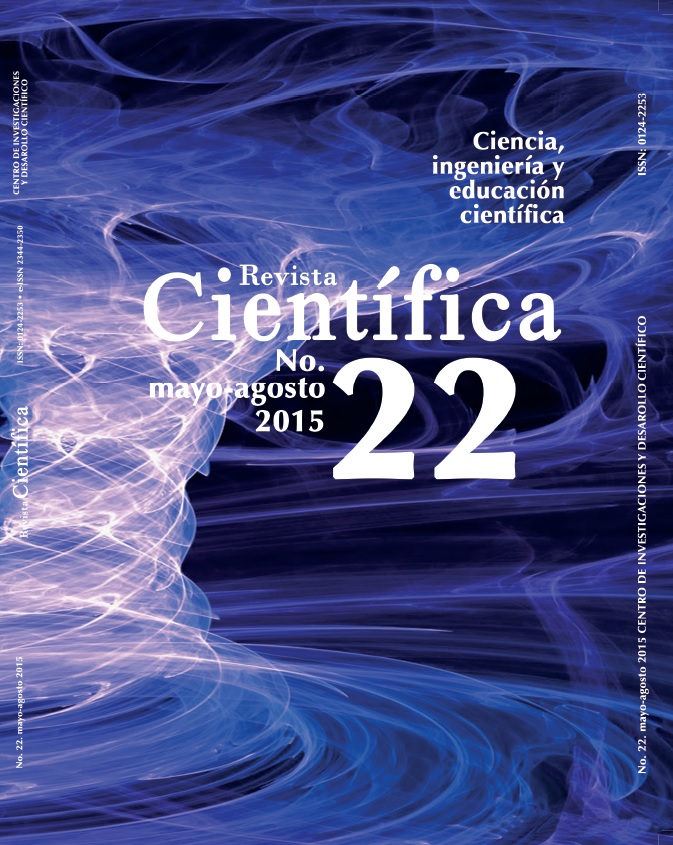DOI:
https://doi.org/10.14483/10.14483/udistrital.jour.RC.2015.22.a4Published:
10/10/2015Issue:
Vol. 22 No. 2 (2015): May-August 2015Section:
Research ArticlesSobre el estado electro-tónico y su interpretación: el potencial vectorial
On the Electro-Tonic State and its Interpretation: The Vector Potential
Keywords:
Estado electro-tónico, potencial vectorial, inducción magnética, formalización, experimento (es).Downloads
Abstract (es)
Se presenta un análisis acerca de las perspectivas que surgieron sobre el potencial vectorial a partir de los escritos originales de Faraday y Maxwell. Se muestran las primeras ideas sobre los experimentos y las explicaciones que Faraday desarrolló en torno a la inducción magnética, y la influencia que tuvo su concepto de estado electro-tónico en la primera explicación que formuló Maxwell, quien lo definió como el estado mediante el cual se ejecutan las acciones magnéticas a través de líneas de fuerza. Señala que ese concepto es la base para explicar el fenómeno de la inducción magnética en términos no newtonianos y lo formaliza mediante la variación temporal de la circulación del potencial vectorial a lo largo de una trayectoria cerrada. Este tipo de análisis muestra la manera en que estos pensadores representan el fenómeno, la cual no se evidencia en la literatura, sino que se muestra como una formalización alrededor del campo magnético.
Abstract (en)
An analysis is presented on the emerging perspectives about the vector potential from Faraday and Maxwell’s original writings. This paper presents the initial observations about the experiments and explanations developed by Faraday on Magnetic Induction and the influence that his concept of Electrotonic State had on Maxwell’s first explanation. He defined it as the state by which magnetic actions are executed through lines of force. He pointed out that this concept is critical to explain the phenomenon of Magnetic Induction in non-Newtonian terms. Therefore, he formalized it by the circulation of vector potential throughout a closed trajectory. This kind of analysis shows how these researchers represented the phenomenon which is not evident in the literature. It’s presented as a formalization around the magnetic field instead.
References
Berkson, W. (1985). Las teorías de los campos de fuerza desde Faraday hasta Einstein. Madrid: Alianza.
Carron, N. (1995).On the fields of a torus and the role of the vector potential. American Journal Of Phisics , 717-729.
Faraday, M. (1831-1855). Experimental Recearches in Electricity, 3 Vols. Londres: University of London.
Faraday, M. (1821/1822). Historical Sketch of Electro-magnetism . Annals of Philosophy , V 18, 195-200, 274-290. V 19, 107-121.
Feynman, R., Leighton, R., & Sands, M. (1987). The Feynman lectures on physics, mainly electromagnetism and matter (Vol. 2). Mexico D.F.: Addison-Wesley Iberoamericana S.A.
Furió, C. y. (1998). Dificultades De Aprendizaje De Los Conceptos De Carga Y De Campo Eléctrico En Estudiantes De Bachillerato Y Universidad. Enseñanza de las ciencias, 131-146.
Giuliani, G. (2010). Vector potential, electromagnetic induction and “physical. European Journal of Physics , 871-880.
Griffiths, D. (1999). Introduction to Electrodynamics. New Jersey: Editorial Prentice Hall.
Guevara, M., Correa, J., Núñez, I., & Scaron, J. M. (1985). Física elementos fundamentales tomo II. Barcelona: Reverté S.A.
Konopinski, E. (1978). What the electromagnetic vector potential describes. American Journal of Physics , 499-502.
Landau D, L. E. (1981). Curso de Física Teorica. Barcelona: Reverté S.A.
Lencinella, D., & Matteucci, G. (2004). An Introduction to the vector potential. European Journal of Physics , 249-256.
Maxwell, J. C. (1965). Scientific Papers of James Clerk Maxwell (Vol. 1). (M. A. Niven, Ed.) New York: Dover Publications.
Maxwell, J. C. (1873). Treatise on Electricity and Magnetism (Vol. I). London: University of Oxford.
Maxwell, J. C. (1873). Treatise on Electricity and Magnetism (Vol. II). London: University of Oxford.
Romo, J., & Doncel, M. (Octubre de 1991). El Concepto del Estado Electro-tónico en Faraday (Tesis Doctoral). Obtenido de Deposit Digital de la UB: http://hdl.handle.net/2445/42074
Rousseaux, G., Kofman, R., & Minazzoli, O. (2008). The Maxwell-Lodge effect: significance of electromagnetic. The European Physical Journal d , 249-256.
Sears, Z. Y. (2004). Física Universitaria. Mexico: Pearson Addison Wesley.
Semon, M., & Taylor, J. (1996). Thoughts on the magnetic vector potential. American Journal of Physics , 1361- 1369.
Tipler, P. A. (1996). Fisica Universitaria. Barcelona: Reverté S.A.
How to Cite
APA
ACM
ACS
ABNT
Chicago
Harvard
IEEE
MLA
Turabian
Vancouver
Download Citation
License
When submitting their article to the Scientific Journal, the author(s) certifies that their manuscript has not been, nor will it be, presented or published in any other scientific journal.
Within the editorial policies established for the Scientific Journal, costs are not established at any stage of the editorial process, the submission of articles, the editing, publication and subsequent downloading of the contents is free of charge, since the journal is a non-profit academic publication. profit.


